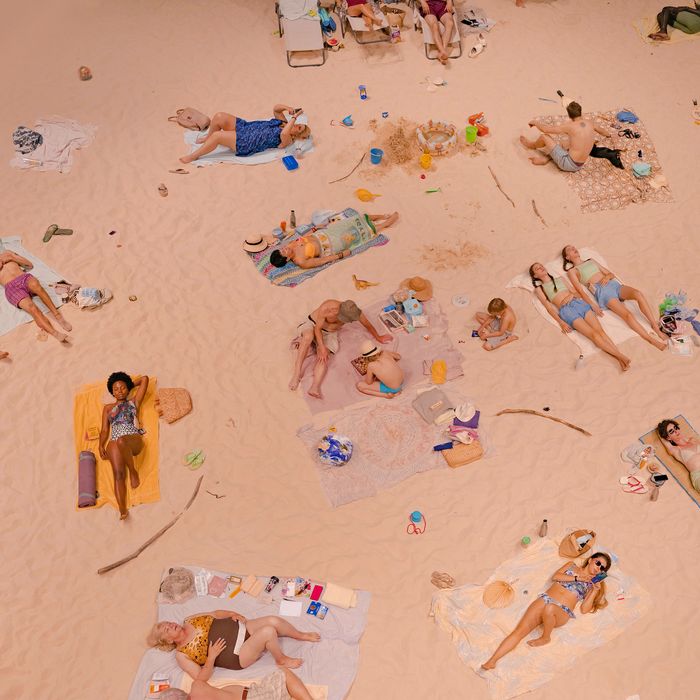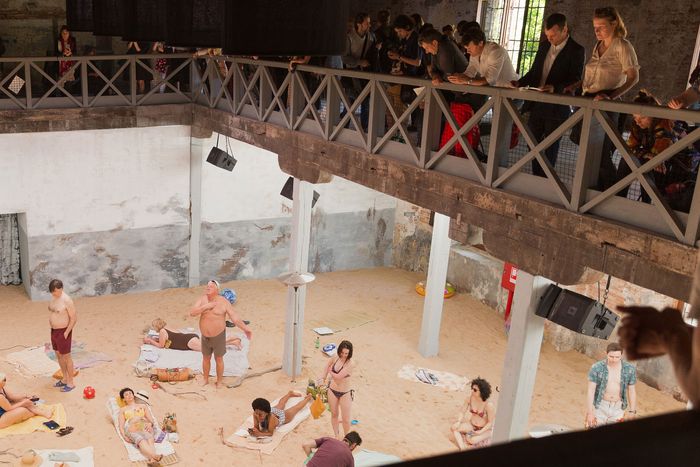
As New Yorkers make their first nervous forays back to theaters and concert halls, BAM is luring audiences into an illusory outdoors. In Sun & Sea, which hovers somewhere between opera, pageant, and installation, viewers stationed in BAM Fisher’s wraparound balcony get a gull’s-eye view of a beach, close enough to smell the suntan lotion. A couple dozen performers lie, barely stirring, on a sand-covered stage, bathed in artificial rays. “The brightness is almost too much to bear,” says the show’s composer, Lina Lapelytė.
The perspective is voyeuristic, but there’s not much more action down below than a bit of lethargic fussing with beach towels. The music is minimal, too: The sunbathers broadcast their inner monologues in vocal lines that are spare, syllabic, and restrained, accompanied by prerecorded buzz, burble, and drone; with no dramatic leaps or flights of coloratura, the characters are distinguished only by subtle changes of pace or intensity. A woman the libretto identifies as “Wealthy Mommy,” reclining alongside her husband and child, sings of racking up visits to various oceans like trophies. Another woman spits out a misanthropic patter: “What’s wrong with people — they come here with their dogs / Who leave shit on the beach, fleas on the sand!” Pollution, carbon emissions, climate change: These global forces are miniaturized into personal anecdotes. “The characters share mundane narratives, singing simple songs and celebrating life, but it all relates to the consumption of planetary resources,” says the poet and playwright Vaiva Grainytė. “Beneath the lighthearted surface is a threat throbbing, though you feel it more like a gentle breeze.”
Sun & Sea is the creation of Lapelytė, Grainytė, and filmmaker Rugilė Barzdžiukaitė, a triumvirate of Lithuanian artists. Although they each have separate careers, they have twice come together for long-simmering collaborations that sneak social critique into deceptively blithe, genre-defying performances. Their first joint effort, Have a Good Day, satirized consumer culture from the point of view of chatting supermarket cashiers and had a run at the Prototype Festival of new operas in 2014. For Sun & Sea, they envisioned the setting, the brilliance, the mood, and the undercurrent of environmental rage long before they came up with a note or a word. Lapelytė, Grainytė, and Barzdžiukaitė started recruiting singers even as they were starting to write, and the people who showed up to auditions shaped the miniature story lines. A church chorister and theology student inspired the character of the Philosopher, who ruminates on the journey of a banana from plantation to fruit bowl. A pair of identical twin sisters came along just as the creative team was reading about attempts to generate corals using 3-D printers. “We started to think maybe one of the girls could be printed that way too,” Grainytė says.
The show was the sleeper hit of the 2019 Venice Biennale, where art tourists stood on two-hour lines for a chance to stand through the hour-long opera and its success won Lithuania the prize for best pavilion. Now, after a pandemic-induced postponement, it takes up residence at BAM — where it features a core cast of Lithuanian and Italian performers — before moving on to Los Angeles’ Museum of Contemporary Art next month. Whether it’s presented in a theater, museum, or, as it was in Berlin last November, in an abandoned swimming pool, “the logistics are pretty complex,” says BAM’s artistic director David Binder. “We have a beach, kids, dogs. There’s no backstage, no curtain, the audience comes and goes. It’s all amplified and mixed live.”
Observing these self-absorbed sunbathers from above gives the audience a certain clinical distance, like scientists studying how climate change infiltrates nearly every aspect of human existence. “We look at people as if they were some other species, like bugs,” says Barzdžiukaitė. “Ideally, it would be from really high up, and you would have a cosmic angle, then zoom in going down and zoom out going up. We’ve discussed how great it would be to do it at the Guggenheim Museum. Maybe one day.”



